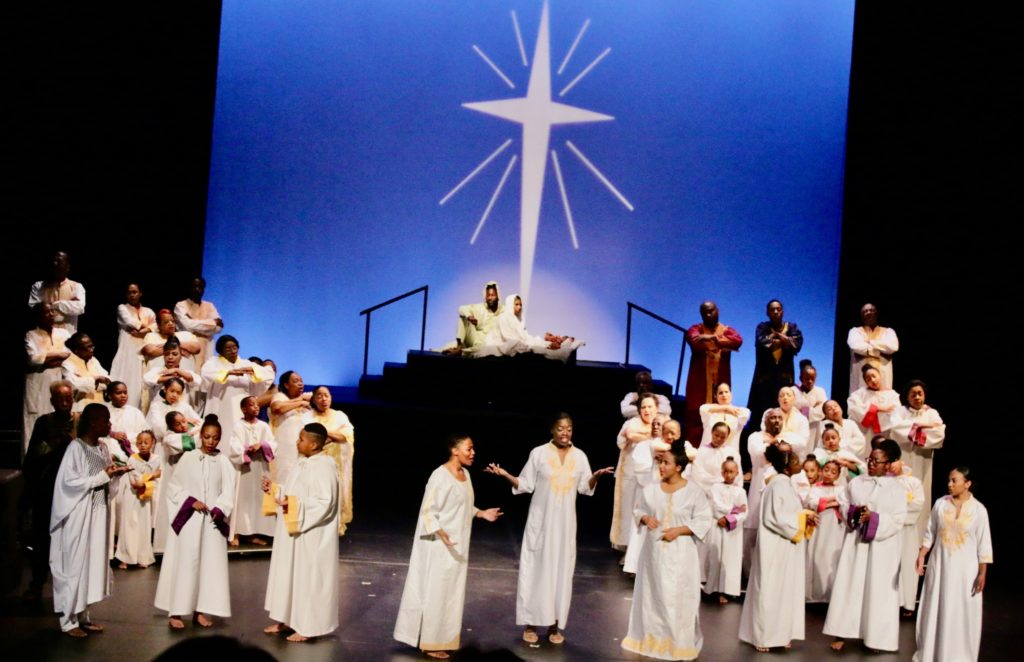
Image from “Black Nativity” Facebook page.
Presented by The National Center of Afro-American Artists
https://blacknativity.org/
Executive Producer and Director: Voncille Ross
Choreographer: George Howard
Ballet Mistress: Desiree Springer
Choral Director, Children of Black Persuasion: Marilyn Andry
Choral Director, Voices of Black Persuasion: Milton L. Wright
Stage Manager: Brion-Michael Rock
Board of Directors – Margaret Burnham and Vivian Johnson, Co-Chairpersons, Kafi Meadows, Frances Bernat, Denzil D. McKenzie, Melissa Nobles, Amy Olatunji, Honorable Milton L. Wright
December 2 – 18, 2022, weekends, with matinees at 3:30 pm and evening shows at 8 pm
Robert J. Orchard Stage
Paramount Center
559 Washington Street
Boston, MA 02111
Review by Craig Idlebrook
BOSTON, Mass — There are competing ideas in the narrative of the traditional Christian nativity story – that the son of God is born and that a young woman who is temporarily homeless gives birth to a child in a barn and the child is loved. One of the most profound aspects of Black Nativity, a long-running production of Langston Hughes’ holiday show, is that it deftly gives equal weight to both.
The poet Hughes, who wrote the book and utilized traditional Christmas carols for this musical, first staged Black Nativity off-Broadway in 1961. Less than a decade later, in 1969, the play was first performed in Boston. The Boston production has become a beloved, if sometimes overlooked, holiday tradition here for more than a half century, and taking part in the cast has become an intergenerational endeavor for some Black families in the area.
The show tells the traditional story of the birth of Jesus through a Black lens, combining bible passages with gospel versions of traditional Christmas carols. The cast combines gospel, traditional African dancing, and live action to bring to life the story of how Mary and Joseph came to Nazareth to pay a tax, and how they then couldn’t find room for Mary’s birth to Jesus, a child who is then celebrated as the son of God.
It is a story that is told so often that its details can be overlooked. However, this production and Hughes’ book do great work to give the audience the chance to see it anew. A highlight of the show is a long wordless number set to dance and drums, illustrating the act of labor before birth. The music and steps help to create a hypnotizing effect, recreating the sacred and hard work of birth.
Also, the production allows us to enjoy the fruits of that labor, as we are treated to a beautiful baby for a few minutes on stage, spit up and all. Child performers, and their sometimes petrified and solemn faces as they belt into song, also offer fresh reminders of the profoundness of the cycle begun anew.
And through it all, we are called to witness the joy of a baby being born in the world through the profound happiness of the music of several dozen gospel singers. Yes, the music bestows us to witness the birth of the son of God, but it was impossible for me to not be reminded of the wonder of seeing any small human’s first moments on this planet.
Not to be overlooked, the show is a welcome counterweight to what is too often a very white season for holiday festivities. It also offers an important rebuttal to the image of Jesus that, throughout my lifetime and before, has too often been portrayed as European to the point of being blond. The show may have become an institution, but its simple, radical pushback against a narrative of white supremacy should not be overlooked.
Most importantly, however, Black Nativity offers a chance to stop during the holiday bustle and feel some joy, and I hope it remains a holiday tradition that my children will take their children to see.
